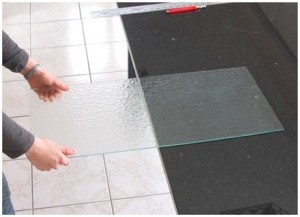Category: ART OF STAINED GLASS
Large sheets, straight score
This type of break looks impressive, even intimidating, but it is one of the easiest.
STEP 1: Score the glass with a cork-backed, steel ruler if necessary. Put enough pressure on the ruler along the length of the score to avoid slipping and shifting of the ruler.
Note: Wood square rulers are frequently used by shopkeepers that routinely make breaks perpendicular to the glass edges. Unlike shopkeepers, most hobbyists aren’t called upon to break down large sheets into more manageable portions at 90° angles, and a lot of art glass does not have straight edges anyway. A cork-backed steel ruler is more polyvalent.
STEP 2: Position the sheet of glass to line up the score against the table. The largest piece of glass after the cut should be on the table, and the smallest piece of glass after the cut should be off the table. Hold the piece of glass to break away on the right and the left.
 STEP 3: Lift the glass – the score line should be 1-2 inches above the edge of the table. Firmly lower the glass with both hands.
STEP 3: Lift the glass – the score line should be 1-2 inches above the edge of the table. Firmly lower the glass with both hands.  STEP 4: The glass will break off against the edge of the table. The larger piece remain on the table, and the smaller piece should be in your hands
STEP 4: The glass will break off against the edge of the table. The larger piece remain on the table, and the smaller piece should be in your hands
Watch this video.
.
HOW TO CUT GLASS
Cutting glass is easy
We tend to associate breaking glass with negative events. The baseball through a window, the precious champagne glass in smithereens on the floor, dangerous shards. While it is recommended, for safety’s sake, to always treat glass with respect, breaking glass in a controlled manner is a pleasurable experience. All you need is to dare to try. It may look intimidating at first, but it is in fact quite easy. There are many ways to cut glass. The techniques explained here are few and simple, yet, they are the very techniques that will later prove invaluable in cutting the most challenging glass with ease.
Types of glass breaks
We will show you how to perform several types of glass breaks, such as:
- Large sheets, straight score
- Medium sheets, straight score
- Breaking off thin pieces, straight score
- Curves, tapping method
- Inside curves





